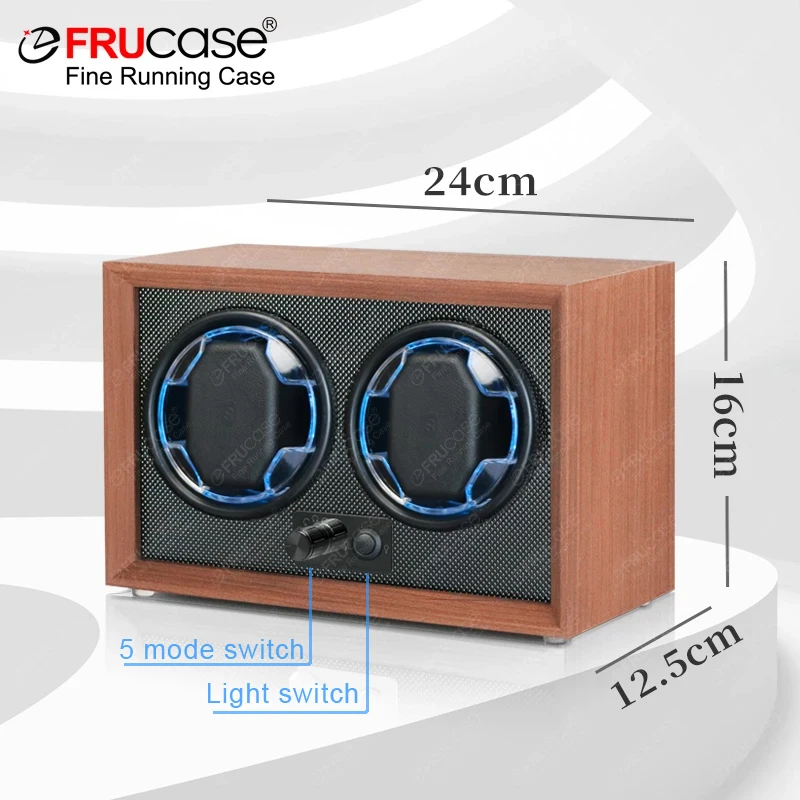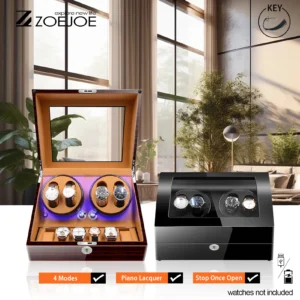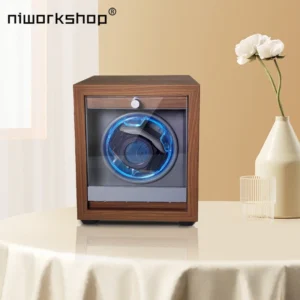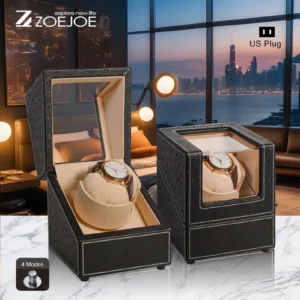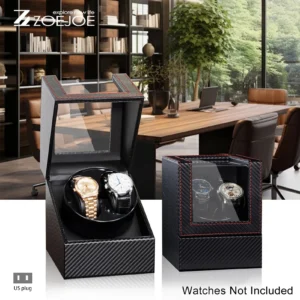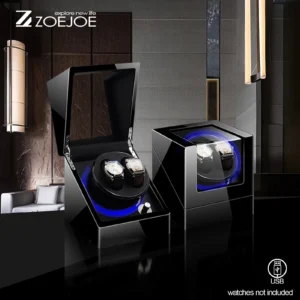Introduction
Automatic watches represent the pinnacle of horological engineering, magnificent timepieces that harness the natural motion of your wrist to stay wound and running. But when these masterpieces aren’t being worn, they require proper care to maintain their precision and functionality. This is where high-quality watch winders enter the picture – and at their core lies a critical component often overlooked: the motor.
The motor is truly the heart of any watch winder system. Just as a premium watch movement dictates the performance of a luxury timepiece, the motor technology in a watch winder determines how effectively it will care for your valuable collection. For collectors and enthusiasts investing hundreds or thousands of dollars in automatic watches, understanding what drives their winding system isn’t just technical curiosity – it’s essential knowledge.
Motor quality directly impacts how gently and precisely your timepieces are treated, how quietly the winder operates, and how many years of reliable service you can expect. In this guide, we’ll explore the technical aspects that separate ordinary motors from exceptional ones, and why these differences matter for watch winder motor specifications and the protection of your cherished timepieces.
The Critical Role of Motor Technology in Watch Winder Performance
The motor in your watch winder performs a deceptively complex task. Far from simply spinning in circles, it must deliver three critical functions simultaneously and consistently over years of operation:
First, it must provide precisely controlled rotation at specific speeds and directions to properly maintain the power reserve in automatic watches. This precision directly impacts how well your timepiece is maintained.
Second, it must operate silently, especially for winders placed in bedrooms or living spaces where noise pollution can become a significant irritant.
Third, it must deliver exceptional reliability over extended periods, often running continuously for years without maintenance or attention.
The technology behind these motors represents a specialized engineering challenge. The motor must translate electrical energy into mechanical motion with extremely specific parameters – not too fast, not too slow, and with minimal vibration or noise generation.
The difference between basic and precision winding is substantial. While a simple motor can create motion, premium motors deliver the exact rotations per day (TPD) required by different watch calibers with minimal variation. This precision ensures your watches receive exactly the motion they need – no more, no less.
Our selection of watch winders incorporates various motor technologies to accommodate different collector needs and preferences, from entry-level to the most demanding applications.
Premium Motor Types in Luxury Watch Winders
Not all motors are created equal when it comes to watch winders. Understanding the types of motors in watch winders can help collectors make informed decisions about which technology best suits their collection’s needs. Let’s explore the premium options that define excellence in the industry.
Japanese Precision Motors
Japanese motor technology, particularly from manufacturers like Mabuchi, has established itself as the benchmark for quality in the mid-to-high-end watch winder market. These motors offer several distinct advantages:
- Exceptional reliability with operational lifespans typically exceeding 10,000 hours
- Quiet operation with noise levels typically in the 10-15dB range (comparable to a whisper)
- Excellent consistency in rotation speed and torque delivery
- Precision manufacturing with tight tolerances for long-term performance
- Optimal balance between premium quality and reasonable cost
Japanese motors represent the sweet spot for many collectors, delivering professional-grade performance without the premium price of European alternatives. They’re typically found in quality watch winders that serve serious collectors who demand reliability and quiet operation.
The engineering philosophy behind these motors emphasizes refinement and reliability over excessive complexity, resulting in systems that maintain consistent performance year after year with minimal maintenance requirements.
Swiss-Engineered Micro Motors
At the pinnacle of watch winder motor technology sit Swiss-engineered micro motors, representing the ultimate in precision and refinement:
- Ultra-quiet operation with noise levels often below 5dB (virtually silent to human ears)
- Coreless design that eliminates cogging and ensures perfectly smooth rotation
- Integration with sophisticated gearhead systems for precise speed control
- Exceptional longevity often exceeding 20,000 hours of operation
- Specialized magnetic shielding to protect sensitive watch movements
These motors are found in the most premium luxury watch winders where cost is no object and absolute performance is demanded. The same Swiss engineering tradition that produces the world’s finest watch movements applies to these motors, with similar attention to microscopic details and tolerances.
The coreless design represents a significant advancement over conventional motors. By eliminating the iron core and using a self-supporting copper coil arrangement, these motors achieve smoother operation with virtually no mechanical noise or magnetic field generation.
German-Engineered Motors
German motor technology brings its own distinctive engineering philosophy to premium watch winders:
- Emphasis on precision machining and tight mechanical tolerances
- Robust design principles for exceptional durability
- Sophisticated electronic control systems for precise speed management
- Noise levels typically between Swiss and Japanese options (6-10dB)
- Excellent torque characteristics even at very low speeds
German motors are often found in artisanal watch winders where engineering quality is paramount. The German approach frequently incorporates advanced materials science and sophisticated control electronics to achieve optimal performance.
These motors typically feature complex internal designs with multiple stages of noise and vibration damping, resulting in whisper-quiet operation without sacrificing mechanical robustness.
Understanding Standard Motors in Lower-End Winders
By contrast, standard motors found in budget watch winders reveal significant compromises:
- Initial quiet operation that deteriorates rapidly with use
- Limited lifespan often under 5,000 hours of operation
- Inconsistent rotation speeds that can fluctuate significantly
- Minimal vibration dampening resulting in increased noise over time
- Potential risk of generating magnetic fields that can affect watch accuracy
The gap between premium and standard motors becomes most apparent after months of continuous operation. While a budget winder might seem adequately quiet when new, lower-quality motors typically develop increased noise, inconsistent rotation, and potential mechanical issues over time.
For valuable timepieces, these limitations represent potential risks to both the winding effectiveness and the long-term health of the watch movement, highlighting why serious collectors invest in winders with superior motor technology.
Essential Performance Metrics for High-End Winder Motors
When evaluating the quality of a watch winder motor, four key performance metrics stand out as definitive indicators of excellence. Understanding these factors helps collectors make informed decisions when investing in winding systems for valuable timepieces.
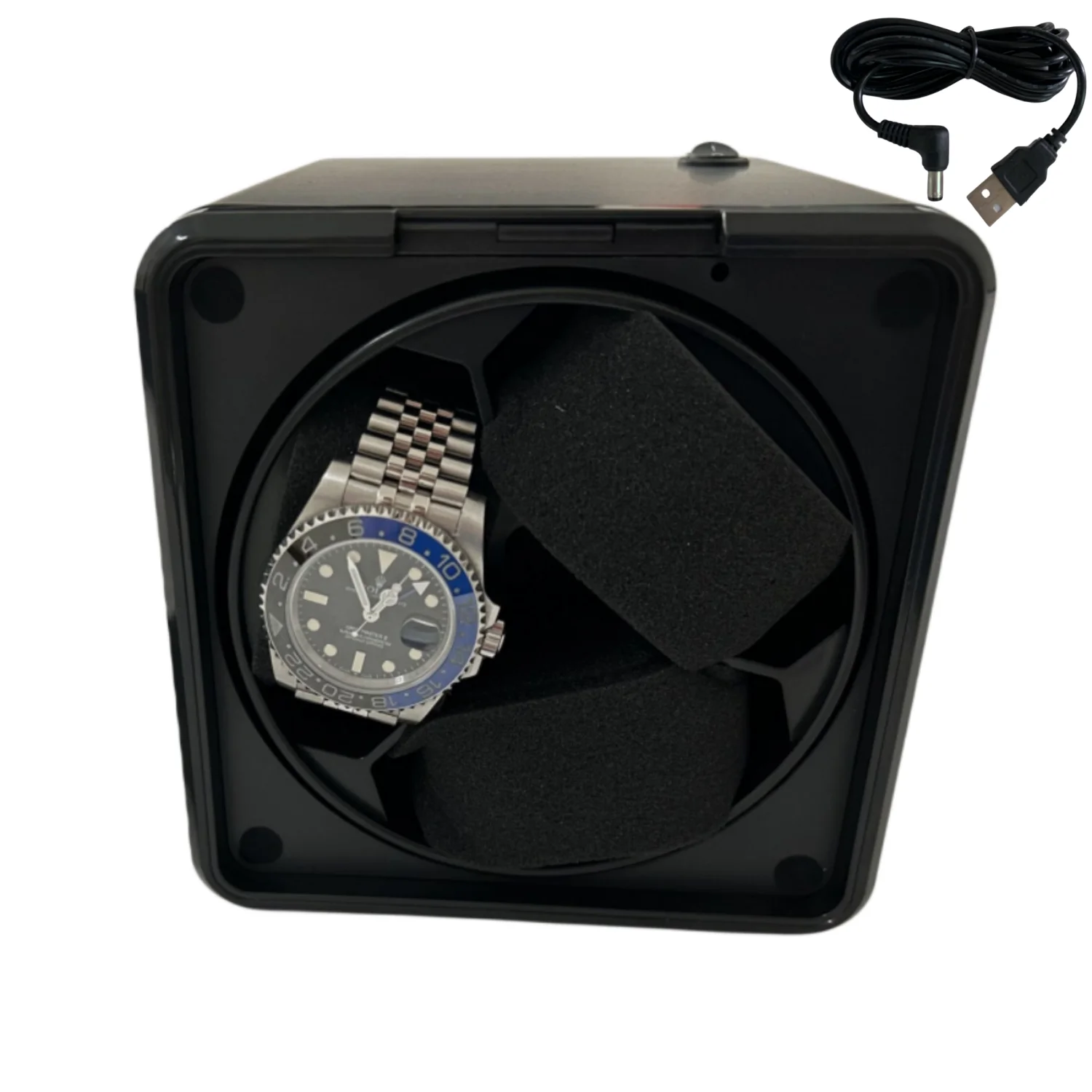
Acoustic Performance: The Science of Silent Operation
One of the most immediately noticeable aspects of motor quality is noise level. Superior watch winders operate with exceptional quietness, a critical feature for winders placed in bedrooms or living areas.
Several technical factors contribute to acoustic performance:
- Bearing quality – Premium bearings minimize friction and vibration
- Motor design – Brushless designs eliminate the noise associated with commutator contact
- Mounting systems – Sophisticated isolation mounts prevent vibration transfer
- Gearing precision – Precisely machined gears mesh more smoothly with less noise
To understand the practical implications of decibel ratings:
- 0-5dB: Virtually inaudible even in complete silence (premium Swiss motors)
- 5-10dB: Barely perceptible in a quiet room (high-end Japanese/German motors)
- 10-15dB: Whisper-quiet but detectable in silent environments (quality standard motors)
- 15dB+: Increasingly noticeable and potentially disruptive (budget motors)
For many collectors, the difference between a 5dB and 15dB motor is the difference between forgetting the winder is operating and being constantly aware of its presence. Our guide to quiet watch winders explores this topic in greater depth.
Longevity and Durability Engineering
High-end watch winder motors are designed for exceptional longevity, often operating continuously for many years without maintenance. Key durability factors include:
- Component quality – Premium ball bearings and electrical components
- Heat management – Efficient designs that minimize operating temperature
- Material selection – Corrosion-resistant metals and high-grade lubricants
- Manufacturing precision – Tight tolerances that reduce wear over time
The operational lifespan difference is substantial:
* Premium motors: 15,000-25,000+ hours (5-10+ years of continuous operation)
* Standard motors: 3,000-8,000 hours (1-3 years of continuous operation)
This durability directly impacts the watch winder motor durability and the long-term value proposition of a quality winder. When protecting timepieces worth thousands or tens of thousands of dollars, motor reliability becomes a critical consideration.
Precision Rotation Control and Programmability
The primary function of any watch winder is to maintain proper winding of automatic watches, which requires precise control over rotation parameters:
- Turns Per Day (TPD) accuracy – Maintaining exact rotation counts for different watch calibers
- Direction control – Clockwise, counterclockwise, or bidirectional options for different movements
- Interval precision – Accurate rest periods between rotation cycles
- Torque consistency – Maintaining smooth, consistent rotation regardless of position
Advanced motors coupled with sophisticated microprocessors enable precise customization of TPD settings for watch winders, allowing collectors to exactly match the winder’s operation to their specific timepieces’ requirements.
Premium motors maintain consistent rotation parameters over their entire operational life, while standard motors may exhibit increasing variation in speed and timing as they age.
Energy Efficiency and Power Management
While often overlooked, energy efficiency represents both an environmental and practical consideration for continuously operating devices:
- Power consumption ranges from under 1 watt for premium motors to 3+ watts for standard ones
- Advanced sleep/wake cycles in premium systems further reduce average consumption
- Lower energy use translates to reduced heat generation, extending component life
- For battery-operated winders, motor efficiency directly impacts operational duration
Understanding how much electricity watch winders use helps collectors appreciate the long-term operating cost differences between motor technologies. While the difference may seem small, over years of continuous operation, premium motors can consume significantly less electricity while delivering superior performance.
Beyond the Motor: The Integrated Drive System
While the motor itself is crucial, it’s just one component of a sophisticated drive system in premium watch winders. Understanding how these elements work together reveals why truly exceptional winders command higher prices and deliver superior performance.
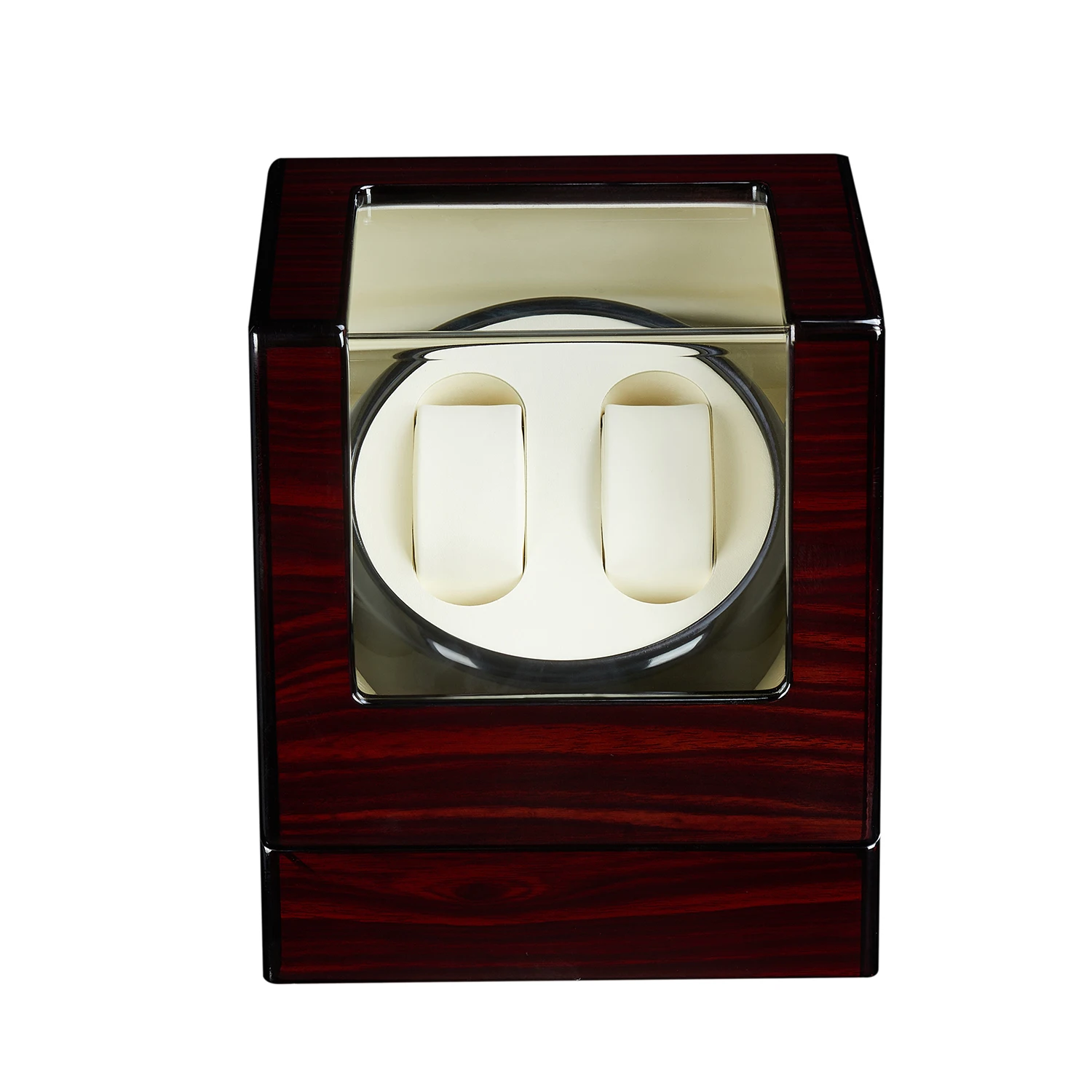
The Critical Role of Precision Gearboxes
The gearbox serves as the critical intermediary between the motor and the winding mechanism, transforming raw motor power into the precise motion needed for watch winding:
- Reduction ratios typically between 50:1 and 100:1 convert high-speed motor rotation to slow, controlled movement
- Material selection (typically brass or engineered polymers) impacts both noise generation and durability
- Gear tooth design and manufacturing precision directly affect operational smoothness
- Lubricant formulation ensures long-term consistency without maintenance
In premium systems, the gearbox often contributes more to noise reduction than the motor itself. The precision machining of gear teeth eliminates the microscopic irregularities that create noise and vibration in standard systems.
Mounting Systems and Vibration Management
Even the finest motor will produce suboptimal results if improperly mounted within the winder:
- Multi-stage isolation mounts decouple the motor/gearbox from the winder structure
- Damping materials strategically placed throughout the drive train absorb vibration
- Balanced rotation cups minimize wobble and vibration during operation
- Structural design elements prevent resonance amplification of motor noise
The most sophisticated winders incorporate multiple vibration-management technologies working in concert, resulting in operation so smooth and quiet that it’s virtually imperceptible even when closely observed.
Automatic Watch Winder, Luxury Watch Winder, Single Watch Box
$307.39 Select options This product has multiple variants. The options may be chosen on the product page4 Watch Winder, 6 Watch Box, Automatic Watch Winder
$512.31 Select options This product has multiple variants. The options may be chosen on the product pageAutomatic Watch Winder, Single Watch Winder, Wooden Watch Holder
$201.76 Select options This product has multiple variants. The options may be chosen on the product pageAutomatic Watch Winder, Leather Watch Travel Case, Single Watch Winder
$146.30 Select options This product has multiple variants. The options may be chosen on the product pageAutomatic Watch Winder, Double Watch Winder, Leather Watch Boxes
$147.60 Select options This product has multiple variants. The options may be chosen on the product pageAutomatic Watch Winder, Double Watch Winder
$206.18 Select options This product has multiple variants. The options may be chosen on the product page
Identifying High-Quality Motor Systems in Premium Winders
For collectors navigating the watch winder market, identifying genuine quality amid marketing claims requires attention to specific indicators. Here’s how to evaluate motor technology when considering an automatic watch winder purchase:
- Look for specific motor type identification rather than vague claims
- Check for detailed noise specifications with actual decibel ratings
- Verify operational hour ratings or expected motor lifespan
- Assess the comprehensiveness of rotation programming options
- Consider the warranty coverage, particularly for the motor components
The most transparent manufacturers will provide detailed specifications about their motor technology, including the specific type, origin, noise level, and expected lifespan. Vague descriptions or an absence of technical details often indicates lower-quality components.
Motor Quality Hallmarks in Premium Brands
The most reputable watch winder manufacturers differentiate themselves through specific approaches to motor technology:
- Explicit identification of motor origin (Japanese, Swiss, German)
- Detailed technical specifications rather than marketing generalities
- Extended warranties specifically covering motor components
- Clear explanations of noise-reduction technologies
- Transparent discussion of operational expectations and limitations
Understanding watch winder warranty and reliability coverage provides insight into a manufacturer’s confidence in their motor technology. Companies using premium motors typically offer more comprehensive coverage for longer periods, reflecting their confidence in component quality.
How Motor Technology Aligns With Different Collector Needs
The ideal motor technology varies based on individual collector circumstances and preferences. Consider these factors when determining which approach best suits your needs:
- Collection value: More valuable collections justify investment in premium motor technology
- Placement location: Bedroom or office locations benefit most from ultra-quiet Swiss or German motors
- Collection size: Larger collections may benefit from the reliability of premium motors across multiple units
- Usage patterns: Continuous operation demands higher durability than occasional use
For vintage timepieces or watches with sensitive movements, motor quality becomes even more critical. The consistent, gentle rotation provided by premium motors helps protect delicate mechanical components from unnecessary stress or potential damage.
Understanding automatic watch winder settings for different watch types helps ensure optimal care regardless of which motor technology you choose.
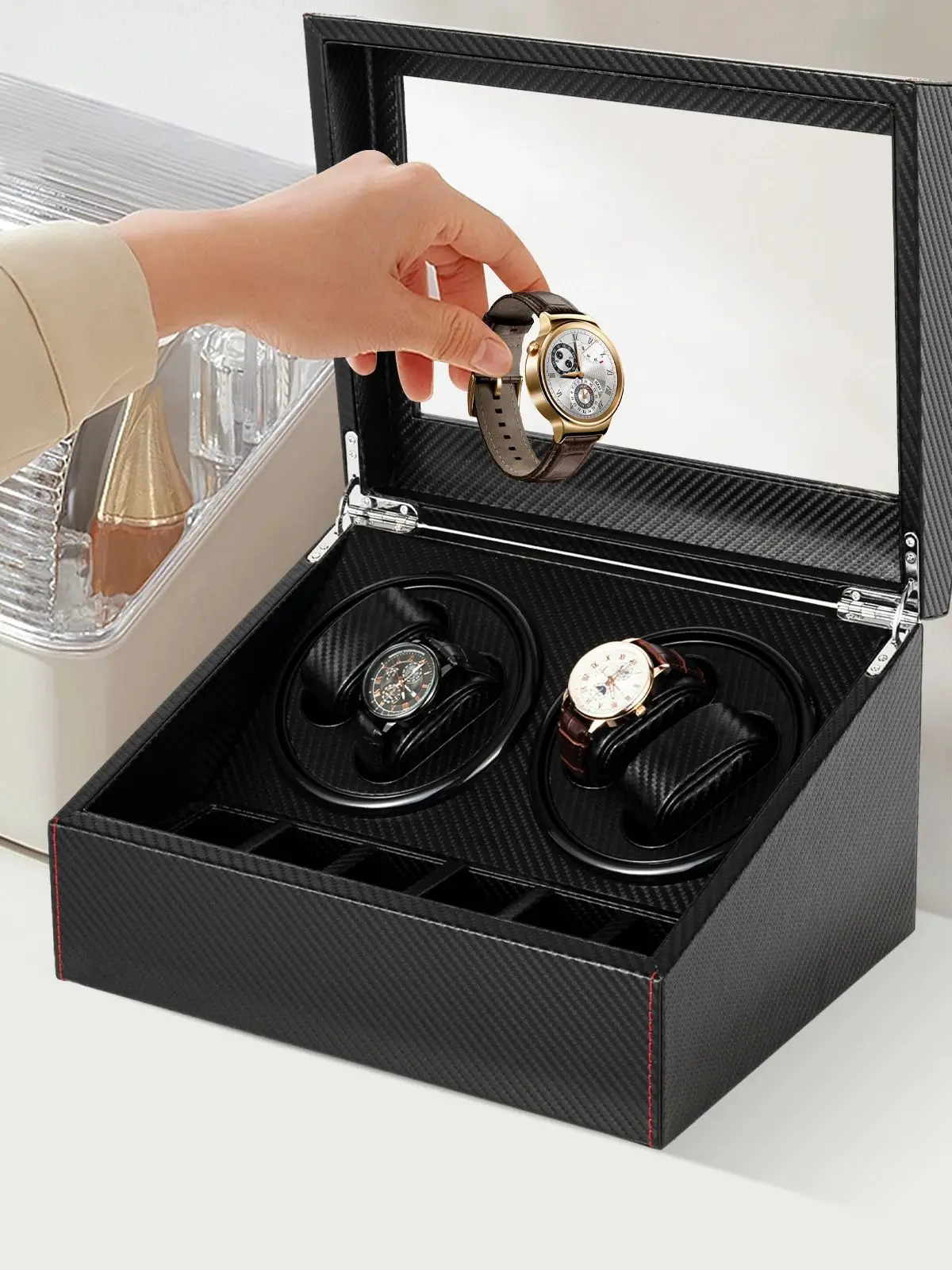
What Questions Should You Ask About Motor Technology?
When evaluating watch winders, asking the right questions about motor technology helps identify truly premium options:
Is Motor Brand Important for Watch Winder Quality?
While specific motor brands can indicate quality (particularly Japanese manufacturers like Mabuchi), what matters most is the overall engineering approach and quality control. Some premium manufacturers develop proprietary motor systems rather than using off-the-shelf components, potentially delivering superior performance without a recognized brand name. Look for specific performance metrics rather than focusing exclusively on brand names.
Can You Upgrade or Replace Watch Winder Motors?
Most watch winders are not designed for motor replacement or upgrades by users. However, quality winders with serviceable designs may offer manufacturer repair options if motor issues develop. Premium brands typically build systems where the motor will outlast other components, making replacement unnecessary under normal conditions. When evaluating long-term ownership, consider the manufacturer’s repair capabilities and parts availability.
How Does Motor Quality Impact Watch Accuracy?
Motor precision directly affects watch accuracy by ensuring consistent winding. Inconsistent rotation can lead to irregular power delivery to the watch movement, potentially affecting timekeeping precision. Premium motors maintain exact TPD settings and smooth operation, ensuring your watches receive optimal winding to maintain their accuracy. For collectors with high-accuracy timepieces, this precision becomes particularly important for maintaining chronometer-level performance.
Final Thoughts: Investing in Superior Motor Technology
The motor technology in a watch winder represents the foundation upon which all other features and benefits depend. While it may be invisible to casual observation, its quality determines the daily experience and long-term satisfaction with your winding system.
For valuable timepiece collections, investing in superior motor technology offers compelling benefits that extend far beyond the winder itself. The quiet, reliable operation of premium motors ensures your watches remain properly wound and protected year after year, without disruption or concern.
When evaluating options for your collection, consider motor quality not as an isolated technical specification, but as a crucial investment in the care and maintenance of your valuable timepieces. The difference between standard and premium motor technology often represents a small percentage of the overall investment but delivers disproportionate benefits in performance, reliability, and peace of mind.
Our collection of single watch winders and multi-watch systems incorporates carefully selected motor technologies to provide optimal care for your timepieces, ensuring they’re always ready to wear and perform at their best.

